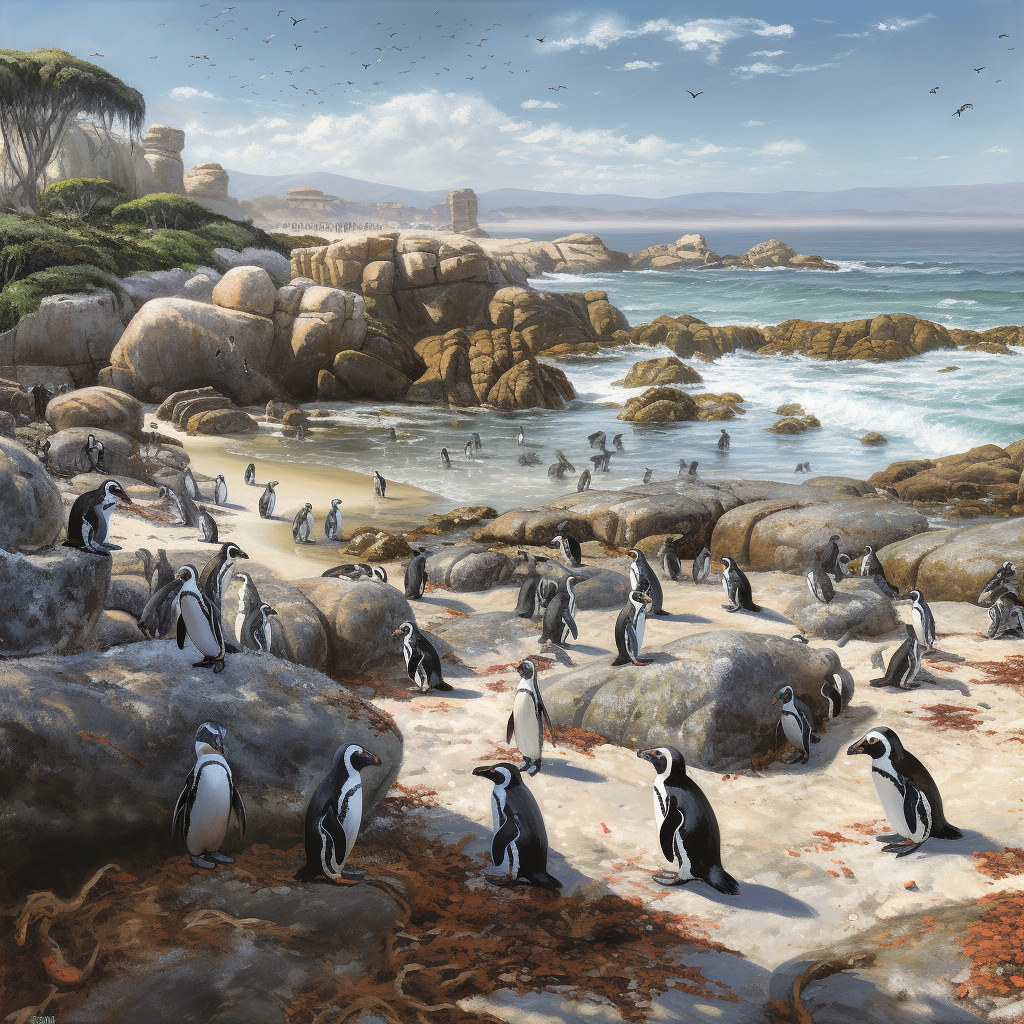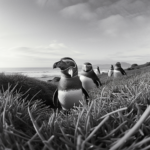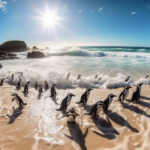African Penguins, also known as the Black-footed Penguins, are fascinating creatures that inhabit the coastal areas of southern Africa. These charismatic birds are native to the rocky shores and islands of Namibia and South Africa, where they have adapted to a unique and challenging habitat. With their distinctive black and white plumage, African Penguins are a sight to behold as they waddle along the sandy beaches and dive into the cool waters of the Atlantic and Indian Oceans. In this article, we will explore the various aspects of the African Penguins’ habitat, including their nesting sites, feeding grounds, and the threats they face in their natural environment. So, let’s dive in and discover the world of African Penguins and the remarkable places they call home.
Key Takeaways
- African penguins are found along the coast of southern Africa, primarily in South Africa and Namibia.
- They prefer rocky shorelines and islands for nesting and breeding.
- African penguins rely on the cold Benguela Current for their food supply, which brings nutrient-rich waters to their habitat.
- Conservation efforts are crucial to protect African penguins and their habitat from threats such as overfishing, pollution, and habitat destruction.
Origin and Distribution of African Penguins
A. Where Do African Penguins Come From?
African penguins, scientifically known as Spheniscus demersus, are native to the coastal areas of southern Africa. These charming birds have a fascinating history that dates back millions of years. The ancestors of African penguins were believed to have originated in Antarctica and gradually migrated to their current habitat.
B. Where Are African Penguins Found?
Today, African penguins can be found along the southwestern coast of Africa, primarily in South Africa and Namibia. They inhabit various offshore islands and mainland colonies, making their homes in a range of coastal environments. One of the most famous locations to observe African penguins is Boulders Beach in Cape Town, South Africa.
C. African Penguin Habitat Map: Key Locations
To get a better understanding of the African penguin’s distribution, let’s take a look at some key locations where these delightful creatures can be found:
-
Boulders Beach, South Africa: Boulders Beach is a popular tourist destination and home to a thriving African penguin colony. Visitors can observe these charismatic birds up close while they go about their daily activities, such as swimming, preening, and nesting.
-
Dassen Island, South Africa: Located off the west coast of South Africa, Dassen Island is an important breeding ground for African penguins. The island provides a safe haven for nesting and raising their chicks away from predators.
-
Robben Island, South Africa: Robben Island, famous for its historical significance, is also home to a small population of African penguins. These penguins share the island with other seabird species, creating a diverse coastal ecosystem.
-
Mercury Island, Namibia: Mercury Island, situated off the coast of Namibia, is another significant breeding site for African penguins. The island‘s rocky terrain and abundant food sources make it an ideal habitat for these seabirds.
-
Stony Point, South Africa: Stony Point, located in Betty’s Bay, South Africa, is home to one of the largest African penguin colonies in the region. Visitors can witness the penguins waddling along the boardwalks and observe their nesting behavior.
It’s important to note that African penguins face numerous threats to their habitat and survival. Factors such as overfishing, pollution, and climate change impact their food sources and nesting sites. Conservation efforts, led by organizations like the World Wildlife Fund (WWF), aim to protect and restore the African penguin population and their coastal habitats.
By understanding the origin and distribution of African penguins, we can appreciate the unique environments they call home and work towards their conservation. These charismatic birds are a testament to the incredible biodiversity found in our oceans and the importance of preserving their habitats for future generations.
Understanding the African Penguins Habitat

A. What is the African Penguins Habitat?
The African penguin, also known as the Spheniscus demersus, is a fascinating species that calls the coastal regions of southern Africa its home. These unique creatures have adapted to thrive in a variety of habitats, from rocky shores to sandy beaches. Let’s take a closer look at the African penguin’s habitat and the characteristics that make it suitable for their survival.
B. African Penguin Natural Habitat Characteristics
African penguins are primarily found along the southwestern coast of Africa, with the largest colonies located in South Africa and Namibia. They inhabit a range of environments, including islands, mainland beaches, and rocky shores. One famous location where these penguins can be observed is Boulders Beach, near Cape Town, South Africa.
These seabirds have specific habitat requirements that contribute to their survival. African penguins prefer areas with easy access to the ocean, as they rely on it for their food source. They are well adapted to both marine and terrestrial life, with their streamlined bodies and webbed feet enabling them to swim swiftly through the water and navigate on land.
C. Habitat Climate: African Penguin Habitat Temperature
The climate of the African penguin’s habitat plays a crucial role in their survival. These penguins are well adapted to the temperate and subtropical climates found along the southern African coast. They can tolerate a wide range of temperatures, from 0 to 30 degrees Celsius (32 to 86 degrees Fahrenheit).
The cool Benguela Current, which flows along the western coast of southern Africa, provides a rich food source for the African penguins. This current brings nutrient-rich waters from the depths of the ocean to the surface, attracting small fish like anchovies and sardines, which are the primary diet of these penguins.
D. South African Penguin Habitat: A Case Study
One of the most significant habitats for African penguins is found in South Africa. Boulders Beach, located near Simon’s Town, is home to a thriving colony of these endangered penguins. This protected area provides a safe haven for the penguins to breed, nest, and raise their young.
The unique geography of Boulders Beach offers shelter from the wind and waves, creating an ideal environment for the penguins. The granite boulders scattered along the beach provide natural nesting sites and offer protection from predators. Visitors to Boulders Beach have the opportunity to observe these charismatic birds up close while respecting their natural habitat.
In recent years, the African penguin population has declined significantly due to various threats, including overfishing, habitat destruction, and pollution. Conservation efforts, such as the establishment of marine protected areas and the promotion of sustainable fishing practices, are crucial in ensuring the long-term survival of these remarkable creatures.
Understanding the African penguin’s habitat is essential for conservationists and researchers working to protect this species. By studying their natural environment and addressing the challenges they face, we can make a positive impact on the future of African penguins and the marine ecosystems they rely on.
African Penguins in Zoos: A Comparative Analysis

A. African Penguin Zoo Habitat Vs Natural Habitat
When it comes to the habitat of African penguins, it is essential to consider both their natural environment and the conditions provided for them in zoos. African penguins are native to the coastal areas of South Africa and Namibia, where they inhabit rocky shores and islands. However, due to various threats, including habitat loss and overfishing, their population has significantly declined in the wild.
In zoos, efforts are made to recreate a suitable environment for African penguins that mimics their natural habitat as closely as possible. This includes providing them with spacious enclosures that resemble their rocky coastal homes. The enclosures often feature a combination of land and water areas, allowing the penguins to exhibit their natural behaviors such as swimming, diving, and socializing.
To ensure the well-being of African penguins in zoos, the temperature and lighting conditions are carefully regulated to match their natural habitat. The enclosures are also equipped with appropriate filtration systems to maintain clean and healthy water for the penguins to swim in. Additionally, zoos often collaborate with conservation organizations and experts to ensure that the penguins’ diet is nutritionally balanced and similar to what they would consume in the wild.
B. African Penguin Habitat Planet Zoo: A Hypothetical Scenario
In a hypothetical scenario, let’s imagine an African penguin habitat in a virtual world, such as the popular simulation game “Planet Zoo.” This game allows players to create and manage their own zoos, including designing habitats for various animal species.
In this virtual African penguin habitat, players would have the opportunity to construct an environment that closely resembles the penguins’ natural habitat. They could incorporate rocky landscapes, sandy beaches, and even artificial pools to provide the penguins with areas for swimming and diving.
To make the habitat more realistic, players could populate it with other South African wildlife, such as seals, pelicans, and various fish species. This would create a dynamic ecosystem within the habitat, simulating the interactions between different coastal bird species and their marine environment.
In this hypothetical scenario, players would also have the opportunity to learn about penguin conservation and the challenges faced by African penguins in the wild. The game could provide educational information about the importance of protecting seabird habitats, the role of penguin breeding grounds, and the impact of overfishing on marine ecosystems.
By immersing players in this virtual African penguin habitat, the game could raise awareness about the conservation efforts needed to protect these endangered penguins. It could inspire players to take action and support real-world initiatives aimed at preserving the African penguin population.
In conclusion, whether in zoos or virtual environments like “Planet Zoo,” efforts are made to provide African penguins with habitats that closely resemble their natural environment. These habitats aim to ensure the well-being of the penguins while also educating and inspiring people to take action in the conservation of this remarkable species.
Threats to the African Penguins Habitat

A. When Did African Penguins Become Endangered?
The African penguin, also known as the African black-footed penguin or Spheniscus demersus, has faced a steady decline in population over the years. These charming creatures, once abundant along the coastlines of southern Africa, are now classified as an endangered species. The decline in their numbers has been a cause for concern among conservationists and wildlife enthusiasts alike.
The African penguin population began to decline rapidly in the early 20th century. At that time, there were an estimated 1.5 million breeding pairs of African penguins. However, due to various factors, including human activities and environmental changes, their numbers have plummeted to around 13% of what they were a century ago. This decline has led to the African penguin being listed as endangered by the International Union for Conservation of Nature (IUCN).
B. Why African Penguins Are Endangered: Key Factors
Several key factors have contributed to the endangered status of African penguins. One of the primary reasons is the loss of their natural habitat. African penguins rely on specific coastal areas for breeding, nesting, and foraging. However, these habitats have been significantly impacted by human activities such as urbanization, pollution, and overfishing.
Overfishing, in particular, has had a detrimental effect on the African penguin population. As their main food source, small fish like anchovies and sardines, become scarce due to overfishing, penguins struggle to find enough food to sustain themselves and their chicks. This scarcity of food leads to malnutrition and a decrease in reproductive success, further exacerbating the decline of the species.
Another significant factor contributing to the decline of African penguins is the presence of oil spills in their habitat. Oil spills can have devastating effects on seabirds, including penguins. When oil coats their feathers, it impairs their ability to regulate body temperature and compromises their buoyancy, making it difficult for them to swim and hunt for food. Additionally, ingesting oil while preening can be toxic and lead to serious health issues.
C. African Penguin Habitat Loss: Causes and Consequences
The loss of African penguin habitat has been a significant consequence of human activities. Coastal development, including the construction of harbors and infrastructure, has encroached upon their natural breeding and nesting sites. This habitat loss disrupts their natural behavior and breeding patterns, making it challenging for the penguins to find suitable places to raise their young.
Furthermore, the destruction of coastal vegetation and sand dunes, which act as natural barriers against erosion and provide shelter for penguin colonies, has further exacerbated the loss of habitat. Without these protective features, penguin colonies are more vulnerable to the impacts of storms and rising sea levels.
The consequences of habitat loss for African penguins are far-reaching. Not only does it directly impact their ability to breed and raise their chicks, but it also disrupts the delicate balance of marine ecosystems. African penguins play a crucial role in these ecosystems by feeding on small fish and krill, thus helping to regulate their populations. Without a stable penguin population, the entire ecosystem can suffer, leading to a cascade of negative effects.
D. African Black Footed Penguin Habitat: A Subspecies in Peril
The African black-footed penguin, a subspecies of the African penguin, faces additional threats to its habitat. This subspecies is found primarily on the southwestern coast of Africa, with its largest colony located at Boulders Beach near Cape Town, South Africa. However, even this protected area is not immune to the challenges faced by African penguins.
Boulders Beach penguins have experienced habitat degradation due to increasing tourism and human disturbance. While visitors are drawn to witness the unique spectacle of penguins in their natural habitat, the sheer number of people can disrupt the penguins’ behavior and cause stress. Additionally, the construction of boardwalks and viewing platforms can further encroach upon their nesting sites and disturb their breeding patterns.
Conservation efforts are underway to protect the African black-footed penguin habitat and ensure the survival of this subspecies. Organizations such as the World Wildlife Fund (WWF) are working to collaborate with local communities, governments, and other stakeholders to implement measures that will safeguard the penguins’ habitat and support their recovery.
In conclusion, the African penguin habitat faces numerous threats that have contributed to their endangered status. Habitat loss, overfishing, oil spills, and human disturbance are key factors that have led to the decline of these charismatic seabirds. Efforts to protect and restore their habitat are crucial for the survival of African penguins and the preservation of the delicate marine ecosystems they inhabit. Conclusion
In conclusion, the African penguins have a unique and fascinating habitat that is crucial for their survival. They are found along the coastlines of southern Africa, specifically in South Africa and Namibia. These penguins rely on a combination of land and sea for their survival, nesting on rocky shores and foraging in the nearby ocean. Their habitat is characterized by a diverse range of ecosystems, including sandy beaches, rocky islands, and coastal vegetation. However, due to various factors such as climate change, overfishing, and habitat destruction, the African penguins are facing significant threats to their habitat and population. Conservation efforts are crucial to protect and restore their habitat, ensuring the survival of these charismatic and endangered birds for future generations. By raising awareness, supporting conservation organizations, and promoting sustainable practices, we can all play a role in safeguarding the African penguins and their habitat. Let’s work together to ensure a bright future for these remarkable creatures and the ecosystems they call home.
Frequently Asked Questions
Where do African penguins come from?
African penguins, also known as Spheniscus demersus, are native to the southern African waters. They are primarily found along the coastlines of South Africa and Namibia.
What habitat do African penguins live in?
African penguins inhabit islands and rocky coastal beaches in the southern African region. Boulders Beach in South Africa is one of the most famous habitats for these penguins. They prefer a marine ecosystem with a cold current, which provides a rich supply of their diet, mainly consisting of fish and squid.
What is the climate of the African penguin’s habitat?
The climate of the African penguin’s habitat is typically temperate. The coastal areas where they live have moderate temperatures, with the ocean‘s cold current helping to moderate the heat.
How is the African penguin habitat represented in Planet Zoo?
In Planet Zoo, the African penguin habitat is represented as a coastal environment with plenty of water for swimming and rocks for nesting. The game aims to replicate their natural environment as closely as possible.
Why are African penguins endangered?
African penguins are endangered due to several factors, including habitat loss, overfishing, climate change, and oil spills. These threats have led to a significant decline in their population over the years.
When did African penguins become endangered?
African penguins were officially listed as endangered in May 2010 by the IUCN Red List of Threatened Species due to a rapid population decline over the previous decades.
What is causing the African penguin habitat loss?
The primary causes of African penguin habitat loss are human activities such as coastal development and disturbance, oil spills, and climate change which alters the distribution of their prey.
What is the African black-footed penguin’s habitat?
The African black-footed penguin, another name for the African penguin, inhabits the same coastal areas of southern Africa. They are often found on islands, rocky shores, and beaches.
Where are African penguins found?
African penguins are found along the coastlines of South Africa and Namibia. They are particularly associated with areas like Boulders Beach and Robben Island in South Africa.
What are some facts about the African penguin’s habitat?
African penguins live in colonies on islands and beaches along the southern African coast. Their habitat is characterized by temperate climate and marine ecosystems rich in their prey. They build nests in burrows they dig in the sand or guano, or sometimes in bushes. They are well adapted to their environment, with a streamlined body for swimming and a layer of fat for insulation against the cold ocean waters.




